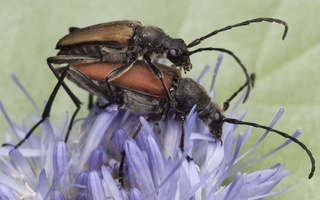- sort orderDefault
Photo title, A → Z
Photo title, Z → A
✔ Date created, new → old
Date created, old → new
Date posted, new → old
Date posted, old → new
Visits, high → low
Random - Google Map
- map
 home / Insecta · vabzdžiai / Coleoptera · vabalai / Cerambycidae · ūsuočiai / Anastrangalia dubia reyi · taiginis žieduolis
home / Insecta · vabzdžiai / Coleoptera · vabalai / Cerambycidae · ūsuočiai / Anastrangalia dubia reyi · taiginis žieduolis

Anastrangalia dubia reyi · taiginis žieduolis
- Gebirgs-Halsbock
- Korpikukkajäärä
- taiginis žieduolis
- zmorsznik północny
- Svartkantad blombock
A survey of Lepturinae Latreille, 1802 (Coleoptera: Cerambycidae) of the south-eastern Baltic region Two taxons of the genus Anastrangalia (= Leptura = Anoplodera), A. dubia (Scopoli, 1763) and A. reyi (Heyden, 1889) = inexpectata (Jansson, Sjöberg, 1928) have been noted for Lithuania as a distinct species since 1960 (Pileckis, 1960). However, the taxonomic position of those, including Siberian A. sequensi (Reitter, 1898), was recently determined based on the analysis of sequences of nucleotides in cytochrome C oxidase I (COI) and all were considered to be subspecies of A. dubia (Zamoroka et al., 2019). Consequently, the previous faunistic data on the taxons from LT should be merged and related to the subspecies A. dubia reyi, because the territory of the region is outside the distribution range of the nominative subspecies A. dubia dubia (Scopoli) or subspecies Anastrangalia dubia sequensi (Reitter) and is within the range of the subspecies of A. dubia reyi only (Zamoroka et al., 2019).
https://en.wikipedia.org/wiki/Anastrangalia_dubia Genders and variations of this species could have different colours. That way, the species can come as black, brown, or red coloured. Usually head, antennae, pronotum and legs are black. In the males the elytrae may be yellow-brown with a dark elytral suture and a more or less broad dark elytral edge, while in the females they are reddish-brown with or without blackish edges. Completely black specimens are more common in females, while in the males they are quite rare.
Larvae of these of wood-boring beetles feed on dead wood, dead branches and tree stumps of various deciduous and coniferous trees (mainly fir, pine and spruce). The development requires two to three years. The adults fly from May to August.
Subfamily: Lepturinae · grakštenėnai
